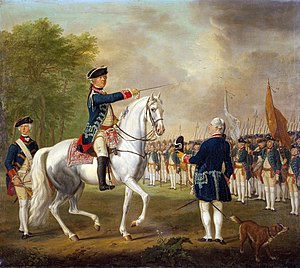
The Dutch Guards (Dutch : Hollandsche Gardes), nicknamed the Blue Guards (Dutch : Blauwe Garde) in the late 17th century, were an elite infantry unit of the army of the United Provinces of the Netherlands, also known as the Dutch Republic.

The Dutch Guards (Dutch : Hollandsche Gardes), nicknamed the Blue Guards (Dutch : Blauwe Garde) in the late 17th century, were an elite infantry unit of the army of the United Provinces of the Netherlands, also known as the Dutch Republic.
In 1573, a company of Foot Guards was raised. In 1599, a guard regiment, called His Highness' Guard Regiment of Foot, or the Regiment Nassau, was created. A second guard regiment, the Regiment of Foot Guards, was raised in 1643, into which the Company of Foot Guards was incorporated. When Prince Willem III became Stadtholder, the Regiment of Foot Guards lost its guard status and became a line regiment; the Company of Foot Guards was transferred to a new guard regiment raised in 1672, named His Highness' Guard Regiment of Foot. This regiment lost all its commanders in the Battle of Seneffe (August 11, 1674); the commander of the Regiment Nassau, Major General Van Solms, amalgamated both regiments into one guard regiment, the Nassau Regiment becoming the 1st battalion, and His Highness' Guard Regiment of Foot becoming the 2nd battalion.
The regiment was renamed His Majesty's Guard Regiment of Foot in 1689. From 1688 to 1699, it served as William III of Orange's Guards regiment. Under King William III, the regiment served in England as his personal guard. During this time, it was also known as the "Blue Guards", because of the Nassau blue coats with yellow/orange cuffs and lining. After Willem III died in 1702, the regiment was renamed the Dutch Guards. The uniform became dark blue with poppy red lining and cuffs; white metal buttons on the coat, and white lace loops; waistcoat and breeches became white. This uniform was worn throughout the 18th century.
In 1699, William negotiated the Second Partition Treaty (with France) in coordination with the Dutch Estates General and Bentinck but left the English Parliament out of the loop. In revenge, they stopped funding his Dutch Guards, and he contemplated abdication:
"I am so angry (William to Heinsius) about what is happening in the House of Commons in the matter of the troops, that I can hardly concentrate my thoughts on anything else. I foresee that I shall have to come to extreme decisions and that I shall see you in Holland earlier than I had intended". [1]
Notable campaigns in which the guards fought included the Nine Years' War (1688–1697) in which distinguished themselves at the Battles of the Boyne and Fleurus along with the siege of Limerick. After the death of William III in 1702, the regiment went back to the Netherlands and during the War of the Spanish Succession (1702–1712) was the backbone of the Dutch Army. In that war, the Dutch Army was the second largest in Europe.[ citation needed ] In particular, the Dutch pioneered the development of platoon fire, which allowed infantry formations to fire continuously, which gave the Dutch an advantage in firepower over armies not using the platoon fire system.
The Blue Guards of the Allied armies under the command of John Churchill, a British general, and distinguished themselves in the Battles of Malplaquet and Oudenaarde. They were not present at the Allied victory of Blenheim, but they greatly distinguished themselves at the Battle of Ramillies, under the command of Colonel Wertmüller, storming two French held villages on the Allied left. They also fought bravely and suffered heavy losses at Malplaquet, fighting under the command of the Prince of Orange on the Allied left flank.
During the War of the Austrian Succession, they took part in the campaign in Germany in 1743, the Battles of Fontenoy and Rocoux and the defence of Brussels and of Bergen op Zoom. After the war, the Republic maintained a policy of strict neutrality. The Dutch Guards came into action once again during the campaigns of 1793 and 1794 against the armies of Revolutionary France.
After the Dutch Republic had been invaded by the French troops in 1795 and the Stadtholderate had come to an end, the Republic was reformed and became the Batavian Republic. The Dutch Guards and other guard units, as representatives of the Ancien Régime, were disbanded the same year.

William III, also widely known as William of Orange, was the sovereign Prince of Orange from birth, Stadtholder of Holland, Zeeland, Utrecht, Guelders, and Overijssel in the Dutch Republic from the 1670s, and King of England, Ireland, and Scotland from 1689 until his death in 1702. As King of Scotland, he is known as William II. He ruled Britain and Ireland alongside his wife, Queen Mary II, and their joint reign is known as that of William and Mary.

John William Friso became the (titular) Prince of Orange in 1702. He was the Stadtholder of Friesland and Groningen in the Dutch Republic until his death by accidental drowning in the Hollands Diep in 1711. From World War II to 2022, Friso and his wife, Marie Louise, were the most recent common ancestors of all then-reigning European monarchs. As of 2023, the most recent common ancestors of all currently-reigning European monarchs are Louis IX, Landgrave of Hesse-Darmstadt and his wife Countess Palatine Caroline of Zweibrücken.
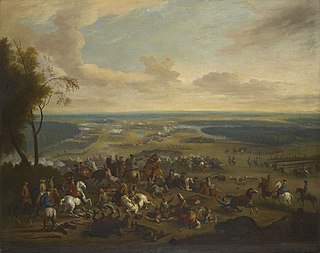
The Battle of Malplaquet took place on 11 September 1709 during the War of the Spanish Succession, near Taisnières-sur-Hon in modern France, then part of the Spanish Netherlands. A French army of around 75,000 men, commanded by the Duke of Villars, engaged a Grand Alliance force of 86,000 under the Duke of Marlborough. In one of the bloodiest battles of the 18th century, the Allies won a narrow victory, but suffered heavy casualties.

Arnold Joost van Keppel, 1st Earl of Albemarle,, and lord of De Voorst in Guelders (Gelderland), was a Dutch military leader who fought for King William III of England and became the first Earl of Albemarle. He was the son of Oswald van Keppel and his wife Anna Geertruid van Lintelo. De Voorst is a large country house near Zutphen, financed by William III, and not unlike the royal palace Het Loo in Apeldoorn.
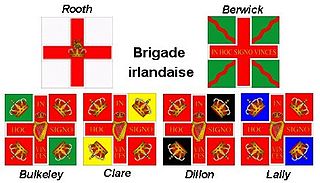
The Irish Brigade was a brigade in the French Royal Army composed of Irish exiles, led by Lord Mountcashel. It was formed in May 1690 when five Jacobite regiments were sent from Ireland to France in exchange for a larger force of French infantry who were sent to fight in the Williamite War in Ireland. The regiments comprising the Irish Brigade retained their special status as foreign units in the French Army until nationalised in 1791.

The Buffs (Royal East Kent Regiment), formerly the 3rd Regiment of Foot, was a line infantry regiment of the British Army traditionally raised in the English county of Kent and garrisoned at Canterbury. It had a history dating back to 1572 and was one of the oldest regiments in the British Army, being third in order of precedence (ranked as the 3rd Regiment of the line). The regiment provided distinguished service over a period of almost four hundred years accumulating one hundred and sixteen battle honours. In 1881, under the Childers Reforms, it was known as the Buffs (East Kent Regiment) and later, on 3 June 1935, was renamed the Buffs (Royal East Kent Regiment).

The Royal Scots Fusiliers was a line infantry regiment of the British Army that existed from 1678 until 1959 when it was amalgamated with the Highland Light Infantry to form the Royal Highland Fusiliers which was later itself merged with the Royal Scots, King's Own Scottish Borderers, the Black Watch, the Argyll and Sutherland Highlanders and the Highlanders to form a new large regiment, the Royal Regiment of Scotland.
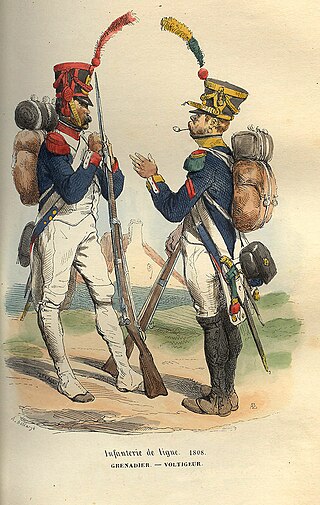
A facing colour is a common tailoring technique for European military uniforms where the visible inside lining of a standard military jacket, coat or tunic is of a different colour to that of the garment itself. The jacket lining evolved to be of different coloured material, then of specific hues. Accordingly, when the material was turned back on itself: the cuffs, lapels and tails of the jacket exposed the contrasting colours of the lining or facings, enabling ready visual distinction of different units: regiments, divisions or battalions each with their own specific and prominent colours. The use of distinctive facings for individual regiments was at its most popular in 18th century armies, but standardisation within infantry branches became more common during and after the Napoleonic Wars.
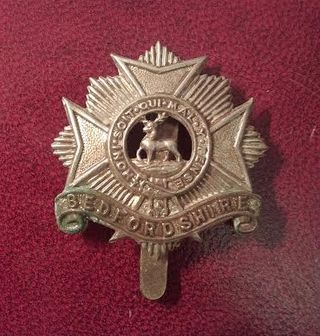
The Bedfordshire and Hertfordshire Regiment was the final title of a line infantry regiment of the British Army that was originally formed in 1688. After centuries of service in many conflicts and wars, including both the First and Second World Wars, the regiment was amalgamated with the Essex Regiment in 1958 to form the 3rd East Anglian Regiment. However, this was short-lived and again was amalgamated, in 1964, with the 1st East Anglian Regiment and 2nd East Anglian Regiment, and the Royal Leicestershire Regiment to form the present Royal Anglian Regiment.

The 5th Dragoon Guards was a British army cavalry regiment, officially formed in January 1686 as Shrewsbury's Regiment of Horse. Following a number of name changes, it became the 5th Regiment of Dragoon Guards in 1804.
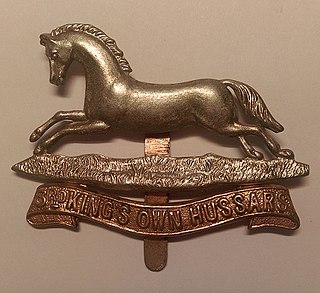
The 3rd Hussars was a cavalry regiment of the British Army, first raised in 1685. It saw service for three centuries, including the First and the Second World Wars, before being amalgamated with the 7th Queen's Own Hussars, to form the Queen's Own Hussars in November 1958.

The French Royal Army was the principal land force of the Kingdom of France. It served the Bourbon dynasty from the reign of Louis XIV in the mid-17th century to that of Charles X in the 19th, with an interlude from 1792 to 1814 and another during the Hundred Days in 1815. It was permanently dissolved following the July Revolution in 1830. The French Royal Army became a model for the new regimental system that was to be imitated throughout Europe from the mid-17th century onward. It was regarded as Europe's greatest military force and the most powerful armies in the world for much of its existence.
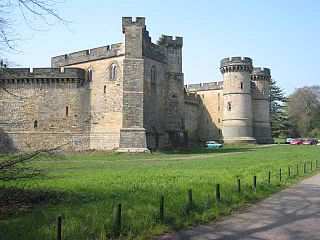
Sir Henry Belasyse, also spelt Bellasis, was an English military officer from County Durham, who also sat as MP for a number of constituencies between 1695 and 1715.

Lieutenant-General George Ramsay was a younger son of the Earl of Dalhousie and Scottish professional soldier.
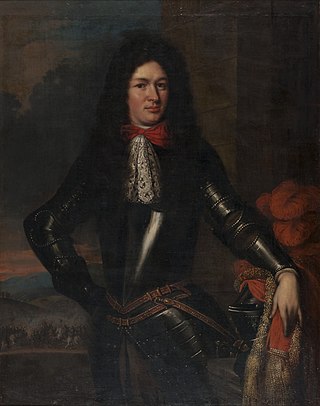
François Nicolas Baron Fagel was an infantry general serving the Dutch Republic. He was a nephew of Gaspar Fagel and took part in many battles during his career. He played an important role in battles such as the Siege of Bonn, the Battle of Malplaquet and the Siege of Bouchain. He was the son of Nicolaas Fagel, mayor of Nijmegen, and Elisabeth Robbé.

The Royal Irish Regiment of Foot Guards, or "His Majesty’s Regiment of Guards in Ireland", was a regiment of foot guards first raised in 1662 for service in Ireland. Part of the Irish Army of Charles II, it was initially garrisoned around Dublin.
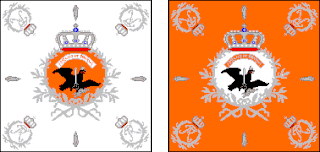
The 1st Prussian Infantry Regiment was a line infantry regiment of the Old Prussian Army which had initially formed part of the Prussian Life Guard, but later transferred to the line. After notably serving in the War of the Austrian Succession and Seven Years' War, the regiment was demolished following the Battle of Auerstadt. A small part of the regiment went on to help form the famed 8th Life Infantry Regiment, which in turn would serve notably till its disbandment after World War I.

Henry Withers was a British army officer and politician, who began his career in 1674 during the Franco-Dutch War and reached the rank of Lieutenant General in 1707. A close associate of the Duke of Marlborough during the War of the Spanish Succession, he served in a number of actions, including the 1704 battles of Schellenberg, Blenheim, and Malplaquet in 1709.
Jacques-Louis, Comte de Noyelles was a Walloon military officer in the service of the Dutch Republic between 1672 and 1708. He was also named an Austrian Field Marshal. He served in the Franco-Dutch War, the Glorious Revolution, the Nine Years' War, and the War of the Spanish Succession in both the northern and the Iberian theatres of that war.

Frederick Christiaan van Reede, 2nd Earl of Athlone, baron of Ginkel and Agrim, lord of Amerongen, was a Dutch general and diplomat in the service of the Dutch Republic during the Nine Years' War and the War of the Spanish Succession.